Report on Expression of Interest & Reflection on Indigenous Work
VerifiedAdded on 2023/06/14
|15
|5636
|316
Report
AI Summary
This assignment is an Expression of Interest and Reflection report designed to assess understanding of concepts related to working effectively with Indigenous Australians in human services. It includes a cover letter for a chosen 'job' within an Indigenous Australian context and responses to criteria related to communication, cultural engagement, kinship systems, and providing sensitive advice. The report also demonstrates comprehension of key course concepts such as cultural competence and awareness of historical issues confronting Indigenous communities. The student reflects on personal experiences and knowledge to showcase their readiness to work in a culturally accountable manner, emphasizing the importance of respect, understanding, and effective communication when engaging with Indigenous Australian families and communities.
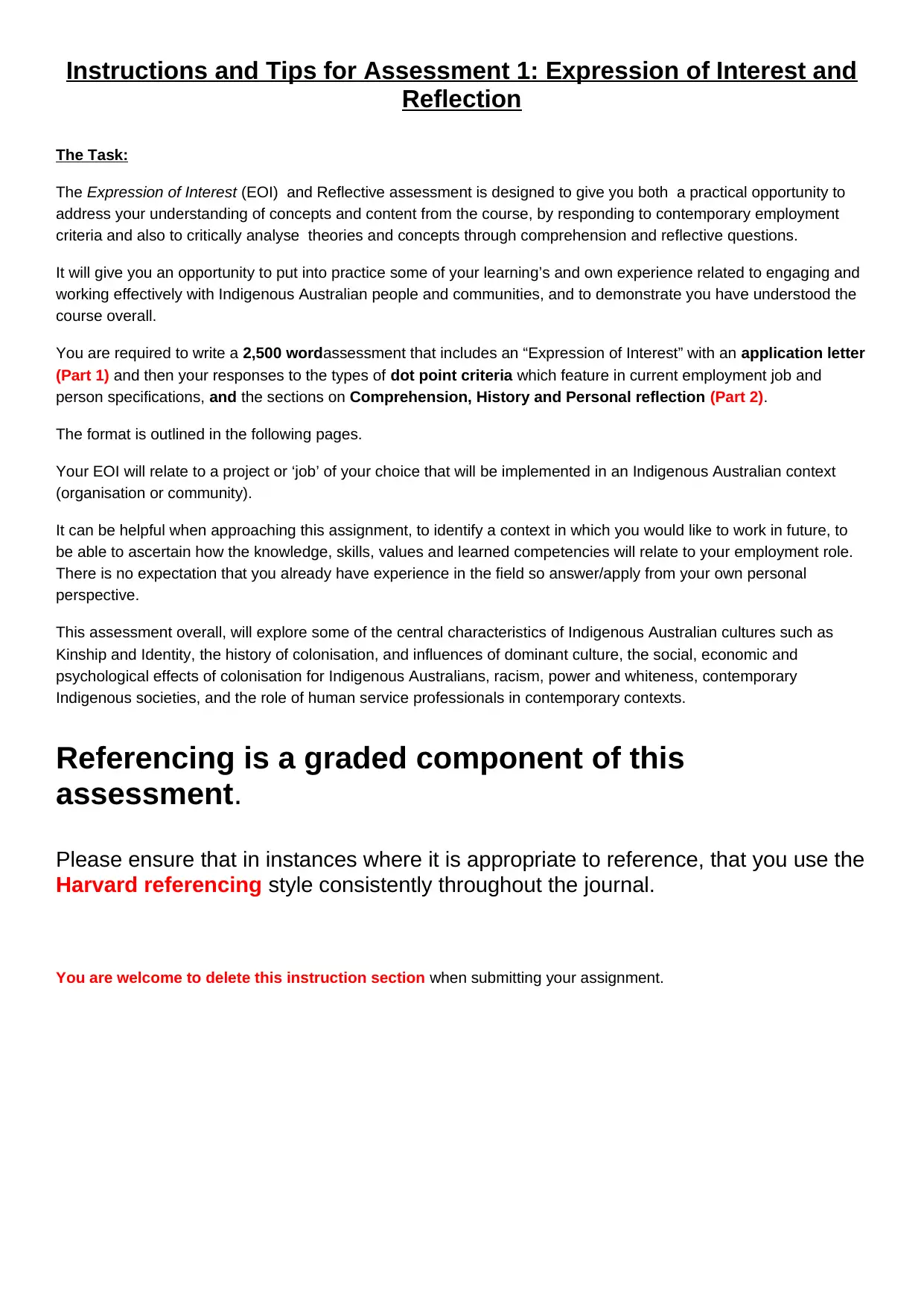
Instructions and Tips for Assessment 1: Expression of Interest and
Reflection
The Task:
The Expression of Interest (EOI) and Reflective assessment is designed to give you both a practical opportunity to
address your understanding of concepts and content from the course, by responding to contemporary employment
criteria and also to critically analyse theories and concepts through comprehension and reflective questions.
It will give you an opportunity to put into practice some of your learning’s and own experience related to engaging and
working effectively with Indigenous Australian people and communities, and to demonstrate you have understood the
course overall.
You are required to write a 2,500 wordassessment that includes an “Expression of Interest” with an application letter
(Part 1) and then your responses to the types of dot point criteria which feature in current employment job and
person specifications, and the sections on Comprehension, History and Personal reflection (Part 2).
The format is outlined in the following pages.
Your EOI will relate to a project or ‘job’ of your choice that will be implemented in an Indigenous Australian context
(organisation or community).
It can be helpful when approaching this assignment, to identify a context in which you would like to work in future, to
be able to ascertain how the knowledge, skills, values and learned competencies will relate to your employment role.
There is no expectation that you already have experience in the field so answer/apply from your own personal
perspective.
This assessment overall, will explore some of the central characteristics of Indigenous Australian cultures such as
Kinship and Identity, the history of colonisation, and influences of dominant culture, the social, economic and
psychological effects of colonisation for Indigenous Australians, racism, power and whiteness, contemporary
Indigenous societies, and the role of human service professionals in contemporary contexts.
Referencing is a graded component of this
assessment.
Please ensure that in instances where it is appropriate to reference, that you use the
Harvard referencing style consistently throughout the journal.
You are welcome to delete this instruction section when submitting your assignment.
Reflection
The Task:
The Expression of Interest (EOI) and Reflective assessment is designed to give you both a practical opportunity to
address your understanding of concepts and content from the course, by responding to contemporary employment
criteria and also to critically analyse theories and concepts through comprehension and reflective questions.
It will give you an opportunity to put into practice some of your learning’s and own experience related to engaging and
working effectively with Indigenous Australian people and communities, and to demonstrate you have understood the
course overall.
You are required to write a 2,500 wordassessment that includes an “Expression of Interest” with an application letter
(Part 1) and then your responses to the types of dot point criteria which feature in current employment job and
person specifications, and the sections on Comprehension, History and Personal reflection (Part 2).
The format is outlined in the following pages.
Your EOI will relate to a project or ‘job’ of your choice that will be implemented in an Indigenous Australian context
(organisation or community).
It can be helpful when approaching this assignment, to identify a context in which you would like to work in future, to
be able to ascertain how the knowledge, skills, values and learned competencies will relate to your employment role.
There is no expectation that you already have experience in the field so answer/apply from your own personal
perspective.
This assessment overall, will explore some of the central characteristics of Indigenous Australian cultures such as
Kinship and Identity, the history of colonisation, and influences of dominant culture, the social, economic and
psychological effects of colonisation for Indigenous Australians, racism, power and whiteness, contemporary
Indigenous societies, and the role of human service professionals in contemporary contexts.
Referencing is a graded component of this
assessment.
Please ensure that in instances where it is appropriate to reference, that you use the
Harvard referencing style consistently throughout the journal.
You are welcome to delete this instruction section when submitting your assignment.
Paraphrase This Document
Need a fresh take? Get an instant paraphrase of this document with our AI Paraphraser
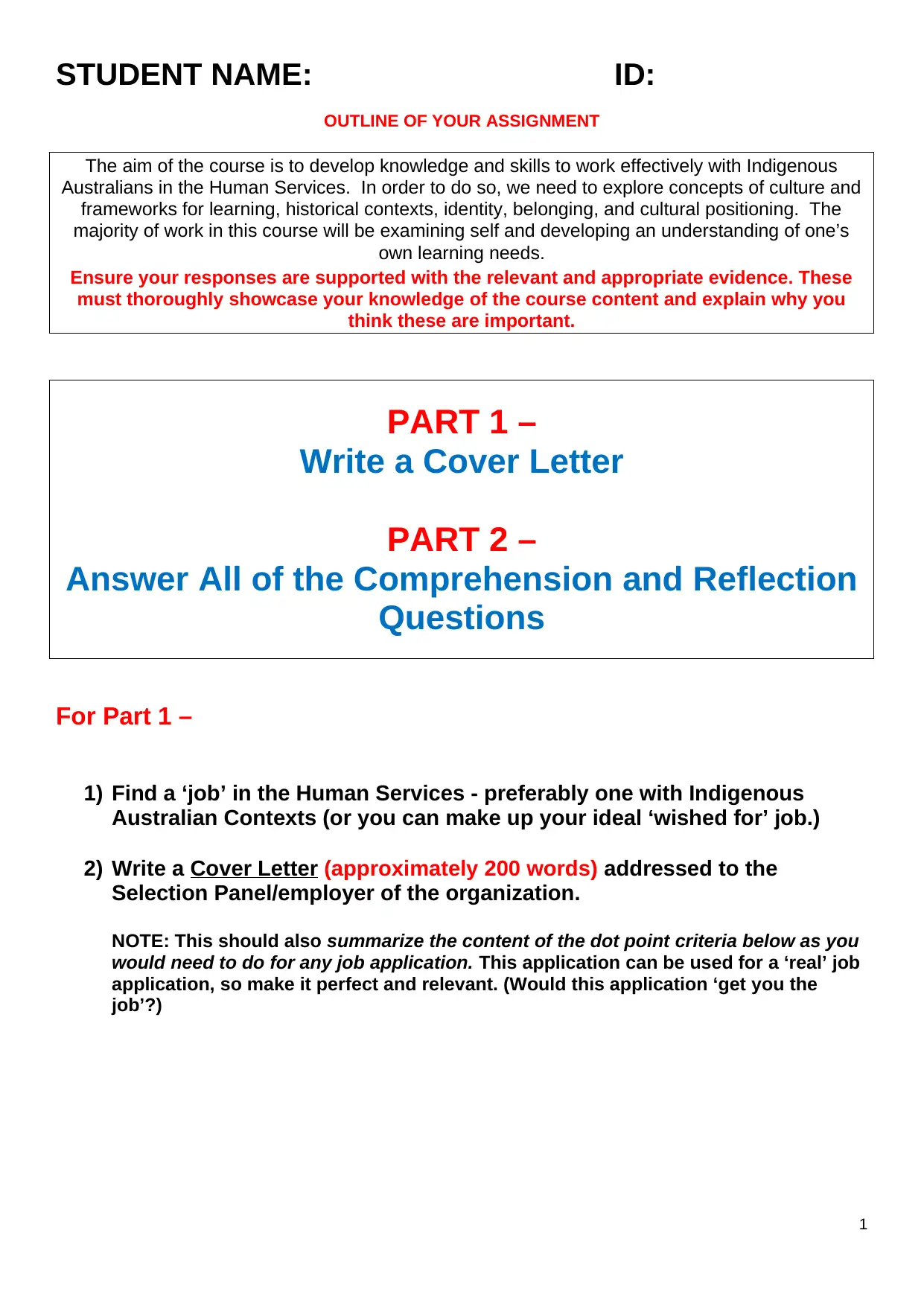
STUDENT NAME: ID:
OUTLINE OF YOUR ASSIGNMENT
The aim of the course is to develop knowledge and skills to work effectively with Indigenous
Australians in the Human Services. In order to do so, we need to explore concepts of culture and
frameworks for learning, historical contexts, identity, belonging, and cultural positioning. The
majority of work in this course will be examining self and developing an understanding of one’s
own learning needs.
Ensure your responses are supported with the relevant and appropriate evidence. These
must thoroughly showcase your knowledge of the course content and explain why you
think these are important.
PART 1 –
Write a Cover Letter
PART 2 –
Answer All of the Comprehension and Reflection
Questions
For Part 1 –
1) Find a ‘job’ in the Human Services - preferably one with Indigenous
Australian Contexts (or you can make up your ideal ‘wished for’ job.)
2) Write a Cover Letter (approximately 200 words) addressed to the
Selection Panel/employer of the organization.
NOTE: This should also summarize the content of the dot point criteria below as you
would need to do for any job application. This application can be used for a ‘real’ job
application, so make it perfect and relevant. (Would this application ‘get you the
job’?)
1
OUTLINE OF YOUR ASSIGNMENT
The aim of the course is to develop knowledge and skills to work effectively with Indigenous
Australians in the Human Services. In order to do so, we need to explore concepts of culture and
frameworks for learning, historical contexts, identity, belonging, and cultural positioning. The
majority of work in this course will be examining self and developing an understanding of one’s
own learning needs.
Ensure your responses are supported with the relevant and appropriate evidence. These
must thoroughly showcase your knowledge of the course content and explain why you
think these are important.
PART 1 –
Write a Cover Letter
PART 2 –
Answer All of the Comprehension and Reflection
Questions
For Part 1 –
1) Find a ‘job’ in the Human Services - preferably one with Indigenous
Australian Contexts (or you can make up your ideal ‘wished for’ job.)
2) Write a Cover Letter (approximately 200 words) addressed to the
Selection Panel/employer of the organization.
NOTE: This should also summarize the content of the dot point criteria below as you
would need to do for any job application. This application can be used for a ‘real’ job
application, so make it perfect and relevant. (Would this application ‘get you the
job’?)
1
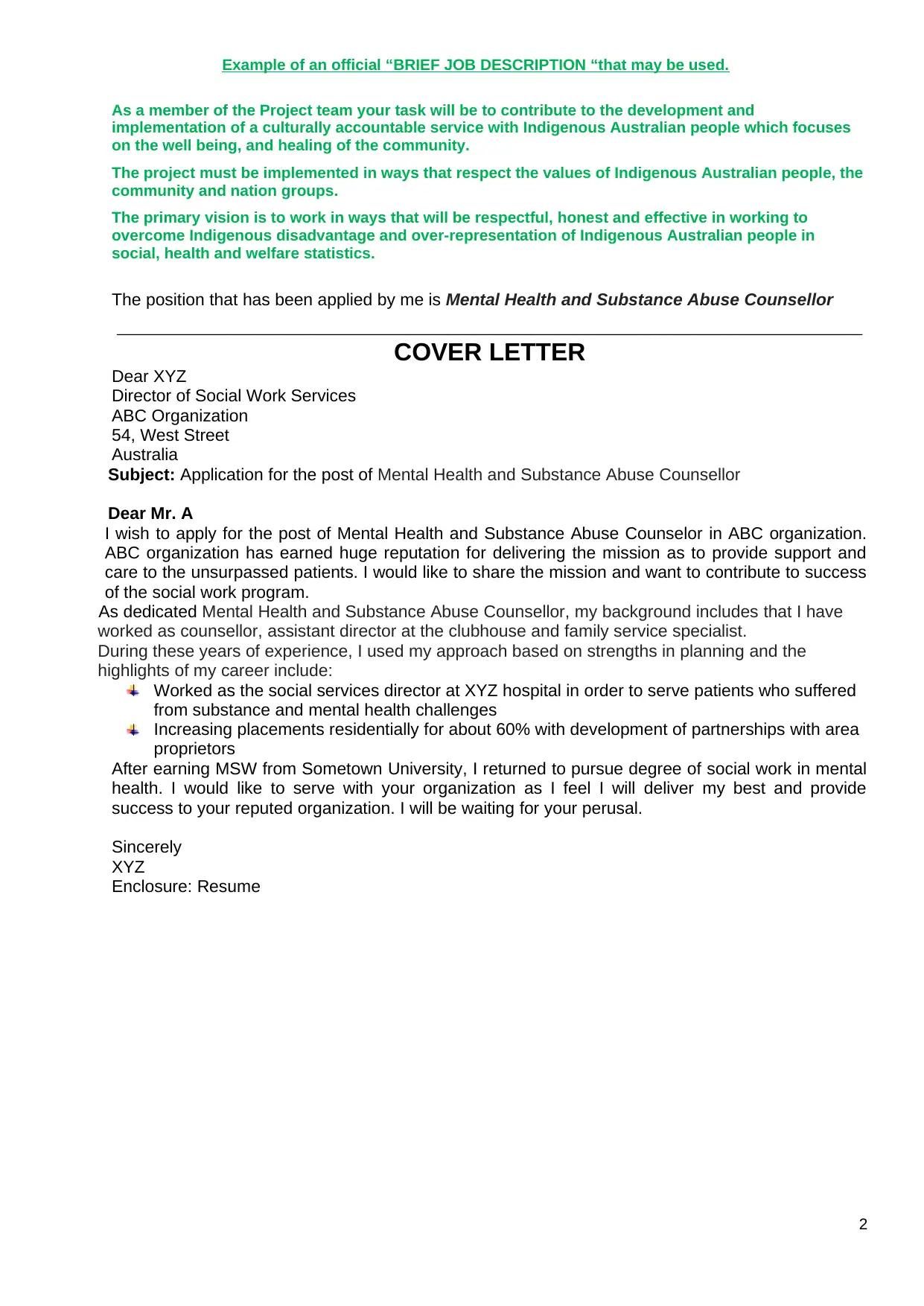
Example of an official “BRIEF JOB DESCRIPTION “that may be used.
As a member of the Project team your task will be to contribute to the development and
implementation of a culturally accountable service with Indigenous Australian people which focuses
on the well being, and healing of the community.
The project must be implemented in ways that respect the values of Indigenous Australian people, the
community and nation groups.
The primary vision is to work in ways that will be respectful, honest and effective in working to
overcome Indigenous disadvantage and over-representation of Indigenous Australian people in
social, health and welfare statistics.
The position that has been applied by me is Mental Health and Substance Abuse Counsellor
______________________________________________________
COVER LETTER
Dear XYZ
Director of Social Work Services
ABC Organization
54, West Street
Australia
Subject: Application for the post of Mental Health and Substance Abuse Counsellor
Dear Mr. A
I wish to apply for the post of Mental Health and Substance Abuse Counselor in ABC organization.
ABC organization has earned huge reputation for delivering the mission as to provide support and
care to the unsurpassed patients. I would like to share the mission and want to contribute to success
of the social work program.
As dedicated Mental Health and Substance Abuse Counsellor, my background includes that I have
worked as counsellor, assistant director at the clubhouse and family service specialist.
During these years of experience, I used my approach based on strengths in planning and the
highlights of my career include:
Worked as the social services director at XYZ hospital in order to serve patients who suffered
from substance and mental health challenges
Increasing placements residentially for about 60% with development of partnerships with area
proprietors
After earning MSW from Sometown University, I returned to pursue degree of social work in mental
health. I would like to serve with your organization as I feel I will deliver my best and provide
success to your reputed organization. I will be waiting for your perusal.
Sincerely
XYZ
Enclosure: Resume
2
As a member of the Project team your task will be to contribute to the development and
implementation of a culturally accountable service with Indigenous Australian people which focuses
on the well being, and healing of the community.
The project must be implemented in ways that respect the values of Indigenous Australian people, the
community and nation groups.
The primary vision is to work in ways that will be respectful, honest and effective in working to
overcome Indigenous disadvantage and over-representation of Indigenous Australian people in
social, health and welfare statistics.
The position that has been applied by me is Mental Health and Substance Abuse Counsellor
______________________________________________________
COVER LETTER
Dear XYZ
Director of Social Work Services
ABC Organization
54, West Street
Australia
Subject: Application for the post of Mental Health and Substance Abuse Counsellor
Dear Mr. A
I wish to apply for the post of Mental Health and Substance Abuse Counselor in ABC organization.
ABC organization has earned huge reputation for delivering the mission as to provide support and
care to the unsurpassed patients. I would like to share the mission and want to contribute to success
of the social work program.
As dedicated Mental Health and Substance Abuse Counsellor, my background includes that I have
worked as counsellor, assistant director at the clubhouse and family service specialist.
During these years of experience, I used my approach based on strengths in planning and the
highlights of my career include:
Worked as the social services director at XYZ hospital in order to serve patients who suffered
from substance and mental health challenges
Increasing placements residentially for about 60% with development of partnerships with area
proprietors
After earning MSW from Sometown University, I returned to pursue degree of social work in mental
health. I would like to serve with your organization as I feel I will deliver my best and provide
success to your reputed organization. I will be waiting for your perusal.
Sincerely
XYZ
Enclosure: Resume
2
⊘ This is a preview!⊘
Do you want full access?
Subscribe today to unlock all pages.

Trusted by 1+ million students worldwide
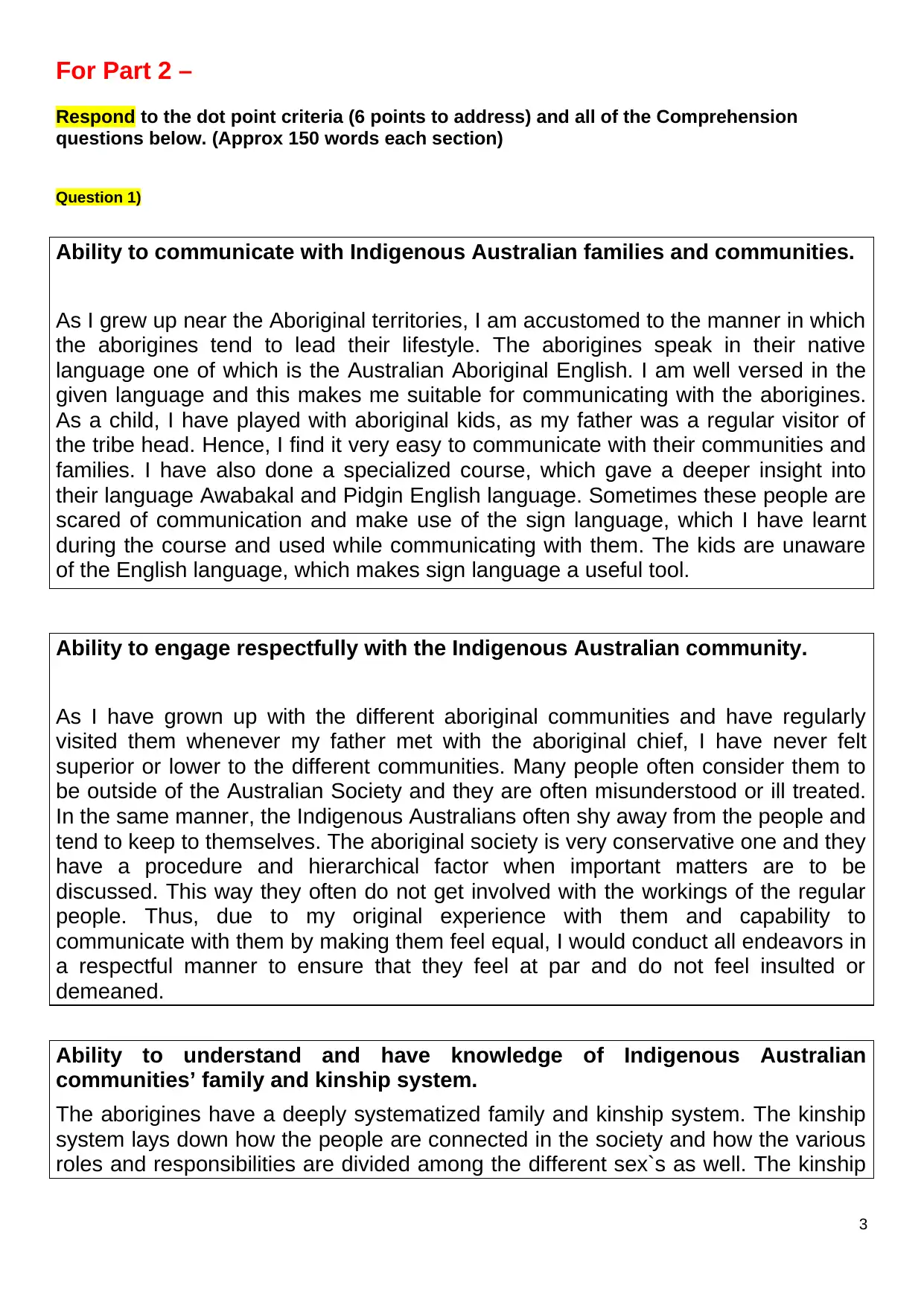
For Part 2 –
Respond to the dot point criteria (6 points to address) and all of the Comprehension
questions below. (Approx 150 words each section)
Question 1)
Ability to communicate with Indigenous Australian families and communities.
As I grew up near the Aboriginal territories, I am accustomed to the manner in which
the aborigines tend to lead their lifestyle. The aborigines speak in their native
language one of which is the Australian Aboriginal English. I am well versed in the
given language and this makes me suitable for communicating with the aborigines.
As a child, I have played with aboriginal kids, as my father was a regular visitor of
the tribe head. Hence, I find it very easy to communicate with their communities and
families. I have also done a specialized course, which gave a deeper insight into
their language Awabakal and Pidgin English language. Sometimes these people are
scared of communication and make use of the sign language, which I have learnt
during the course and used while communicating with them. The kids are unaware
of the English language, which makes sign language a useful tool.
Ability to engage respectfully with the Indigenous Australian community.
As I have grown up with the different aboriginal communities and have regularly
visited them whenever my father met with the aboriginal chief, I have never felt
superior or lower to the different communities. Many people often consider them to
be outside of the Australian Society and they are often misunderstood or ill treated.
In the same manner, the Indigenous Australians often shy away from the people and
tend to keep to themselves. The aboriginal society is very conservative one and they
have a procedure and hierarchical factor when important matters are to be
discussed. This way they often do not get involved with the workings of the regular
people. Thus, due to my original experience with them and capability to
communicate with them by making them feel equal, I would conduct all endeavors in
a respectful manner to ensure that they feel at par and do not feel insulted or
demeaned.
Ability to understand and have knowledge of Indigenous Australian
communities’ family and kinship system.
The aborigines have a deeply systematized family and kinship system. The kinship
system lays down how the people are connected in the society and how the various
roles and responsibilities are divided among the different sex`s as well. The kinship
3
Respond to the dot point criteria (6 points to address) and all of the Comprehension
questions below. (Approx 150 words each section)
Question 1)
Ability to communicate with Indigenous Australian families and communities.
As I grew up near the Aboriginal territories, I am accustomed to the manner in which
the aborigines tend to lead their lifestyle. The aborigines speak in their native
language one of which is the Australian Aboriginal English. I am well versed in the
given language and this makes me suitable for communicating with the aborigines.
As a child, I have played with aboriginal kids, as my father was a regular visitor of
the tribe head. Hence, I find it very easy to communicate with their communities and
families. I have also done a specialized course, which gave a deeper insight into
their language Awabakal and Pidgin English language. Sometimes these people are
scared of communication and make use of the sign language, which I have learnt
during the course and used while communicating with them. The kids are unaware
of the English language, which makes sign language a useful tool.
Ability to engage respectfully with the Indigenous Australian community.
As I have grown up with the different aboriginal communities and have regularly
visited them whenever my father met with the aboriginal chief, I have never felt
superior or lower to the different communities. Many people often consider them to
be outside of the Australian Society and they are often misunderstood or ill treated.
In the same manner, the Indigenous Australians often shy away from the people and
tend to keep to themselves. The aboriginal society is very conservative one and they
have a procedure and hierarchical factor when important matters are to be
discussed. This way they often do not get involved with the workings of the regular
people. Thus, due to my original experience with them and capability to
communicate with them by making them feel equal, I would conduct all endeavors in
a respectful manner to ensure that they feel at par and do not feel insulted or
demeaned.
Ability to understand and have knowledge of Indigenous Australian
communities’ family and kinship system.
The aborigines have a deeply systematized family and kinship system. The kinship
system lays down how the people are connected in the society and how the various
roles and responsibilities are divided among the different sex`s as well. The kinship
3
Paraphrase This Document
Need a fresh take? Get an instant paraphrase of this document with our AI Paraphraser
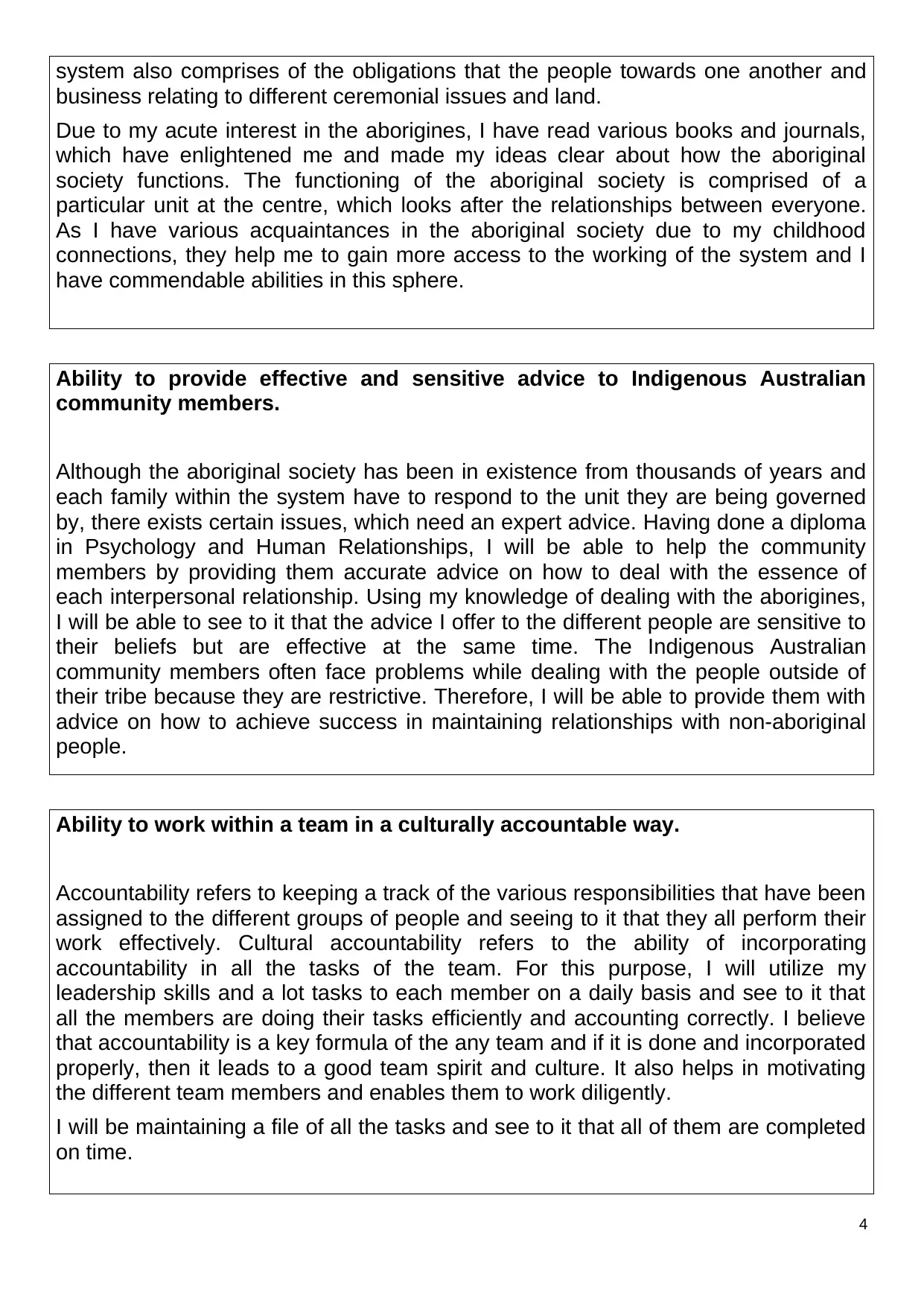
system also comprises of the obligations that the people towards one another and
business relating to different ceremonial issues and land.
Due to my acute interest in the aborigines, I have read various books and journals,
which have enlightened me and made my ideas clear about how the aboriginal
society functions. The functioning of the aboriginal society is comprised of a
particular unit at the centre, which looks after the relationships between everyone.
As I have various acquaintances in the aboriginal society due to my childhood
connections, they help me to gain more access to the working of the system and I
have commendable abilities in this sphere.
Ability to provide effective and sensitive advice to Indigenous Australian
community members.
Although the aboriginal society has been in existence from thousands of years and
each family within the system have to respond to the unit they are being governed
by, there exists certain issues, which need an expert advice. Having done a diploma
in Psychology and Human Relationships, I will be able to help the community
members by providing them accurate advice on how to deal with the essence of
each interpersonal relationship. Using my knowledge of dealing with the aborigines,
I will be able to see to it that the advice I offer to the different people are sensitive to
their beliefs but are effective at the same time. The Indigenous Australian
community members often face problems while dealing with the people outside of
their tribe because they are restrictive. Therefore, I will be able to provide them with
advice on how to achieve success in maintaining relationships with non-aboriginal
people.
Ability to work within a team in a culturally accountable way.
Accountability refers to keeping a track of the various responsibilities that have been
assigned to the different groups of people and seeing to it that they all perform their
work effectively. Cultural accountability refers to the ability of incorporating
accountability in all the tasks of the team. For this purpose, I will utilize my
leadership skills and a lot tasks to each member on a daily basis and see to it that
all the members are doing their tasks efficiently and accounting correctly. I believe
that accountability is a key formula of the any team and if it is done and incorporated
properly, then it leads to a good team spirit and culture. It also helps in motivating
the different team members and enables them to work diligently.
I will be maintaining a file of all the tasks and see to it that all of them are completed
on time.
4
business relating to different ceremonial issues and land.
Due to my acute interest in the aborigines, I have read various books and journals,
which have enlightened me and made my ideas clear about how the aboriginal
society functions. The functioning of the aboriginal society is comprised of a
particular unit at the centre, which looks after the relationships between everyone.
As I have various acquaintances in the aboriginal society due to my childhood
connections, they help me to gain more access to the working of the system and I
have commendable abilities in this sphere.
Ability to provide effective and sensitive advice to Indigenous Australian
community members.
Although the aboriginal society has been in existence from thousands of years and
each family within the system have to respond to the unit they are being governed
by, there exists certain issues, which need an expert advice. Having done a diploma
in Psychology and Human Relationships, I will be able to help the community
members by providing them accurate advice on how to deal with the essence of
each interpersonal relationship. Using my knowledge of dealing with the aborigines,
I will be able to see to it that the advice I offer to the different people are sensitive to
their beliefs but are effective at the same time. The Indigenous Australian
community members often face problems while dealing with the people outside of
their tribe because they are restrictive. Therefore, I will be able to provide them with
advice on how to achieve success in maintaining relationships with non-aboriginal
people.
Ability to work within a team in a culturally accountable way.
Accountability refers to keeping a track of the various responsibilities that have been
assigned to the different groups of people and seeing to it that they all perform their
work effectively. Cultural accountability refers to the ability of incorporating
accountability in all the tasks of the team. For this purpose, I will utilize my
leadership skills and a lot tasks to each member on a daily basis and see to it that
all the members are doing their tasks efficiently and accounting correctly. I believe
that accountability is a key formula of the any team and if it is done and incorporated
properly, then it leads to a good team spirit and culture. It also helps in motivating
the different team members and enables them to work diligently.
I will be maintaining a file of all the tasks and see to it that all of them are completed
on time.
4
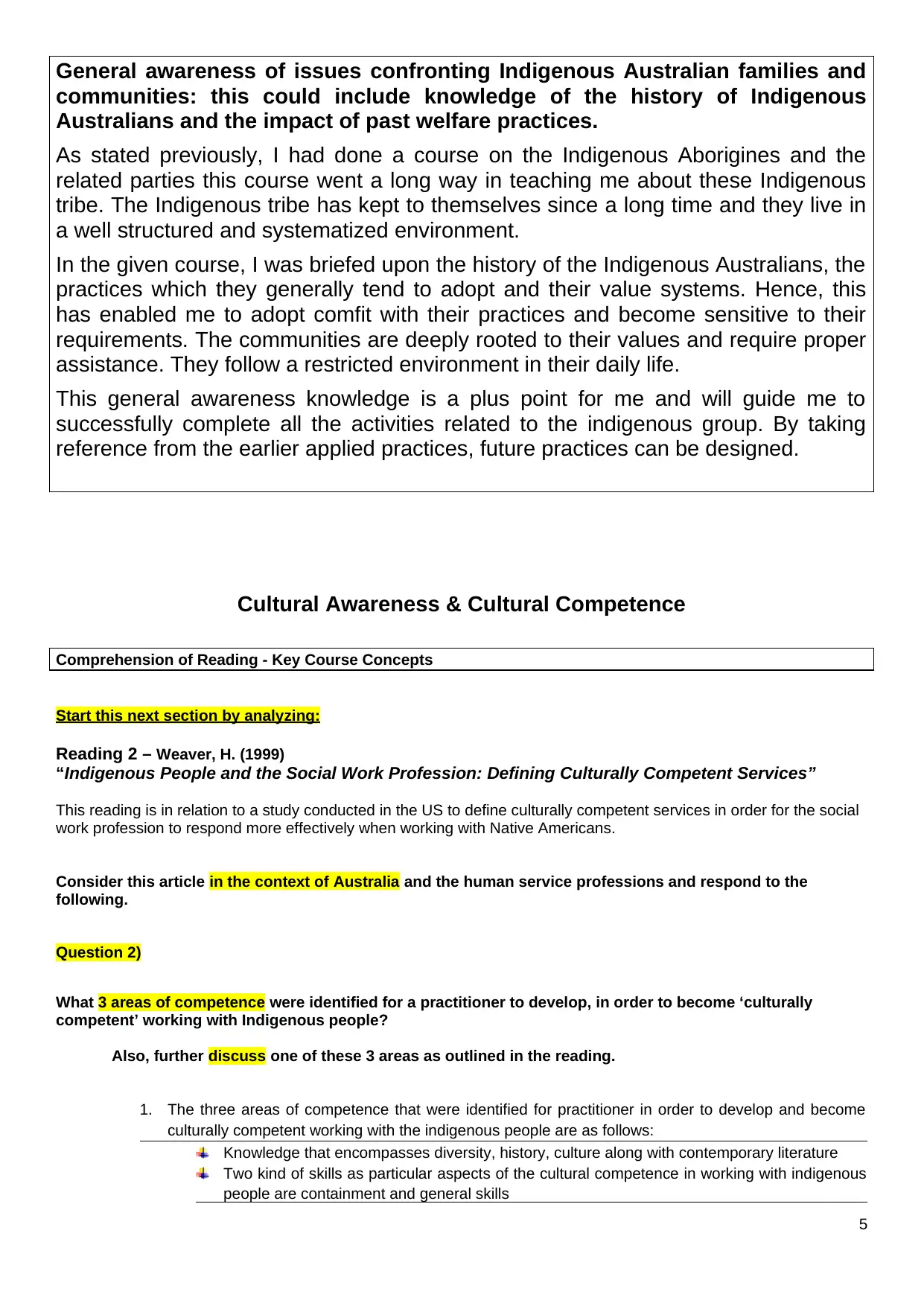
General awareness of issues confronting Indigenous Australian families and
communities: this could include knowledge of the history of Indigenous
Australians and the impact of past welfare practices.
As stated previously, I had done a course on the Indigenous Aborigines and the
related parties this course went a long way in teaching me about these Indigenous
tribe. The Indigenous tribe has kept to themselves since a long time and they live in
a well structured and systematized environment.
In the given course, I was briefed upon the history of the Indigenous Australians, the
practices which they generally tend to adopt and their value systems. Hence, this
has enabled me to adopt comfit with their practices and become sensitive to their
requirements. The communities are deeply rooted to their values and require proper
assistance. They follow a restricted environment in their daily life.
This general awareness knowledge is a plus point for me and will guide me to
successfully complete all the activities related to the indigenous group. By taking
reference from the earlier applied practices, future practices can be designed.
Cultural Awareness & Cultural Competence
Comprehension of Reading - Key Course Concepts
Start this next section by analyzing:
Reading 2 – Weaver, H. (1999)
“Indigenous People and the Social Work Profession: Defining Culturally Competent Services”
This reading is in relation to a study conducted in the US to define culturally competent services in order for the social
work profession to respond more effectively when working with Native Americans.
Consider this article in the context of Australia and the human service professions and respond to the
following.
Question 2)
What 3 areas of competence were identified for a practitioner to develop, in order to become ‘culturally
competent’ working with Indigenous people?
Also, further discuss one of these 3 areas as outlined in the reading.
1. The three areas of competence that were identified for practitioner in order to develop and become
culturally competent working with the indigenous people are as follows:
Knowledge that encompasses diversity, history, culture along with contemporary literature
Two kind of skills as particular aspects of the cultural competence in working with indigenous
people are containment and general skills
5
communities: this could include knowledge of the history of Indigenous
Australians and the impact of past welfare practices.
As stated previously, I had done a course on the Indigenous Aborigines and the
related parties this course went a long way in teaching me about these Indigenous
tribe. The Indigenous tribe has kept to themselves since a long time and they live in
a well structured and systematized environment.
In the given course, I was briefed upon the history of the Indigenous Australians, the
practices which they generally tend to adopt and their value systems. Hence, this
has enabled me to adopt comfit with their practices and become sensitive to their
requirements. The communities are deeply rooted to their values and require proper
assistance. They follow a restricted environment in their daily life.
This general awareness knowledge is a plus point for me and will guide me to
successfully complete all the activities related to the indigenous group. By taking
reference from the earlier applied practices, future practices can be designed.
Cultural Awareness & Cultural Competence
Comprehension of Reading - Key Course Concepts
Start this next section by analyzing:
Reading 2 – Weaver, H. (1999)
“Indigenous People and the Social Work Profession: Defining Culturally Competent Services”
This reading is in relation to a study conducted in the US to define culturally competent services in order for the social
work profession to respond more effectively when working with Native Americans.
Consider this article in the context of Australia and the human service professions and respond to the
following.
Question 2)
What 3 areas of competence were identified for a practitioner to develop, in order to become ‘culturally
competent’ working with Indigenous people?
Also, further discuss one of these 3 areas as outlined in the reading.
1. The three areas of competence that were identified for practitioner in order to develop and become
culturally competent working with the indigenous people are as follows:
Knowledge that encompasses diversity, history, culture along with contemporary literature
Two kind of skills as particular aspects of the cultural competence in working with indigenous
people are containment and general skills
5
⊘ This is a preview!⊘
Do you want full access?
Subscribe today to unlock all pages.

Trusted by 1+ million students worldwide
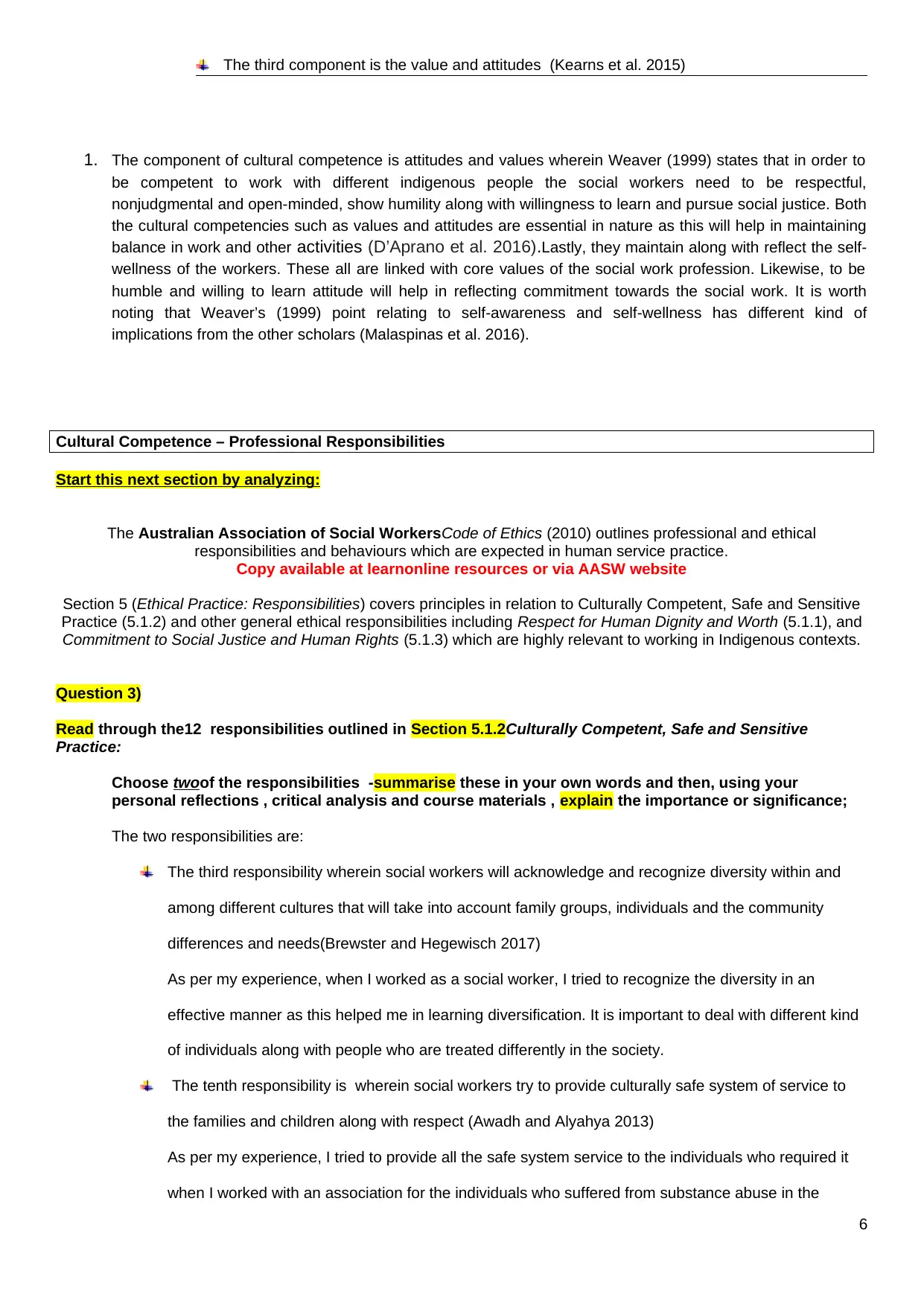
The third component is the value and attitudes (Kearns et al. 2015)
1. The component of cultural competence is attitudes and values wherein Weaver (1999) states that in order to
be competent to work with different indigenous people the social workers need to be respectful,
nonjudgmental and open-minded, show humility along with willingness to learn and pursue social justice. Both
the cultural competencies such as values and attitudes are essential in nature as this will help in maintaining
balance in work and other activities (D’Aprano et al. 2016).Lastly, they maintain along with reflect the self-
wellness of the workers. These all are linked with core values of the social work profession. Likewise, to be
humble and willing to learn attitude will help in reflecting commitment towards the social work. It is worth
noting that Weaver’s (1999) point relating to self-awareness and self-wellness has different kind of
implications from the other scholars (Malaspinas et al. 2016).
Cultural Competence – Professional Responsibilities
Start this next section by analyzing:
The Australian Association of Social WorkersCode of Ethics (2010) outlines professional and ethical
responsibilities and behaviours which are expected in human service practice.
Copy available at learnonline resources or via AASW website
Section 5 (Ethical Practice: Responsibilities) covers principles in relation to Culturally Competent, Safe and Sensitive
Practice (5.1.2) and other general ethical responsibilities including Respect for Human Dignity and Worth (5.1.1), and
Commitment to Social Justice and Human Rights (5.1.3) which are highly relevant to working in Indigenous contexts.
Question 3)
Read through the12 responsibilities outlined in Section 5.1.2Culturally Competent, Safe and Sensitive
Practice:
Choose twoof the responsibilities -summarise these in your own words and then, using your
personal reflections , critical analysis and course materials , explain the importance or significance;
The two responsibilities are:
The third responsibility wherein social workers will acknowledge and recognize diversity within and
among different cultures that will take into account family groups, individuals and the community
differences and needs(Brewster and Hegewisch 2017)
As per my experience, when I worked as a social worker, I tried to recognize the diversity in an
effective manner as this helped me in learning diversification. It is important to deal with different kind
of individuals along with people who are treated differently in the society.
The tenth responsibility is wherein social workers try to provide culturally safe system of service to
the families and children along with respect (Awadh and Alyahya 2013)
As per my experience, I tried to provide all the safe system service to the individuals who required it
when I worked with an association for the individuals who suffered from substance abuse in the
6
1. The component of cultural competence is attitudes and values wherein Weaver (1999) states that in order to
be competent to work with different indigenous people the social workers need to be respectful,
nonjudgmental and open-minded, show humility along with willingness to learn and pursue social justice. Both
the cultural competencies such as values and attitudes are essential in nature as this will help in maintaining
balance in work and other activities (D’Aprano et al. 2016).Lastly, they maintain along with reflect the self-
wellness of the workers. These all are linked with core values of the social work profession. Likewise, to be
humble and willing to learn attitude will help in reflecting commitment towards the social work. It is worth
noting that Weaver’s (1999) point relating to self-awareness and self-wellness has different kind of
implications from the other scholars (Malaspinas et al. 2016).
Cultural Competence – Professional Responsibilities
Start this next section by analyzing:
The Australian Association of Social WorkersCode of Ethics (2010) outlines professional and ethical
responsibilities and behaviours which are expected in human service practice.
Copy available at learnonline resources or via AASW website
Section 5 (Ethical Practice: Responsibilities) covers principles in relation to Culturally Competent, Safe and Sensitive
Practice (5.1.2) and other general ethical responsibilities including Respect for Human Dignity and Worth (5.1.1), and
Commitment to Social Justice and Human Rights (5.1.3) which are highly relevant to working in Indigenous contexts.
Question 3)
Read through the12 responsibilities outlined in Section 5.1.2Culturally Competent, Safe and Sensitive
Practice:
Choose twoof the responsibilities -summarise these in your own words and then, using your
personal reflections , critical analysis and course materials , explain the importance or significance;
The two responsibilities are:
The third responsibility wherein social workers will acknowledge and recognize diversity within and
among different cultures that will take into account family groups, individuals and the community
differences and needs(Brewster and Hegewisch 2017)
As per my experience, when I worked as a social worker, I tried to recognize the diversity in an
effective manner as this helped me in learning diversification. It is important to deal with different kind
of individuals along with people who are treated differently in the society.
The tenth responsibility is wherein social workers try to provide culturally safe system of service to
the families and children along with respect (Awadh and Alyahya 2013)
As per my experience, I tried to provide all the safe system service to the individuals who required it
when I worked with an association for the individuals who suffered from substance abuse in the
6
Paraphrase This Document
Need a fresh take? Get an instant paraphrase of this document with our AI Paraphraser
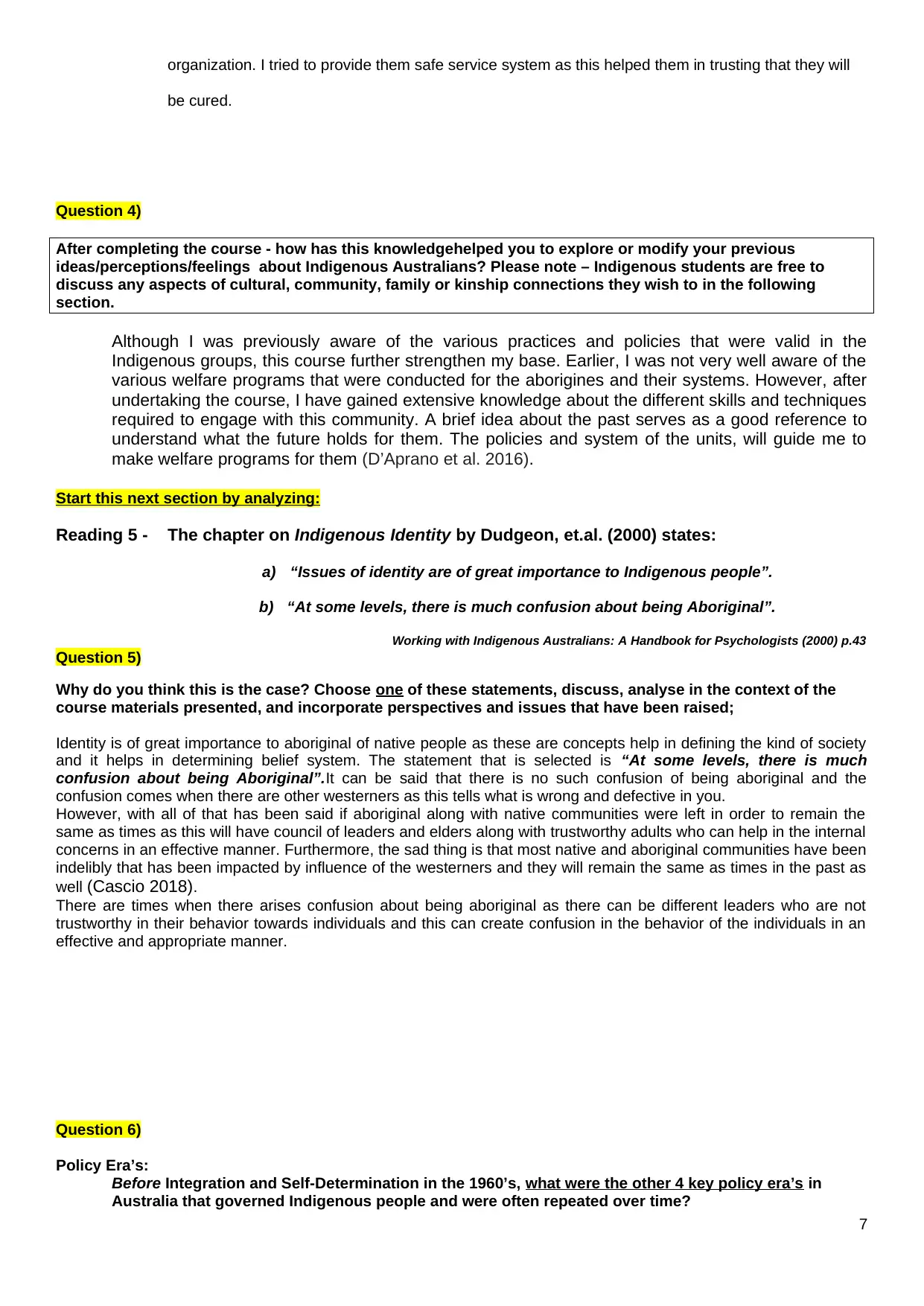
organization. I tried to provide them safe service system as this helped them in trusting that they will
be cured.
Question 4)
After completing the course - how has this knowledgehelped you to explore or modify your previous
ideas/perceptions/feelings about Indigenous Australians? Please note – Indigenous students are free to
discuss any aspects of cultural, community, family or kinship connections they wish to in the following
section.
Although I was previously aware of the various practices and policies that were valid in the
Indigenous groups, this course further strengthen my base. Earlier, I was not very well aware of the
various welfare programs that were conducted for the aborigines and their systems. However, after
undertaking the course, I have gained extensive knowledge about the different skills and techniques
required to engage with this community. A brief idea about the past serves as a good reference to
understand what the future holds for them. The policies and system of the units, will guide me to
make welfare programs for them (D’Aprano et al. 2016).
Start this next section by analyzing:
Reading 5 - The chapter on Indigenous Identity by Dudgeon, et.al. (2000) states:
a) “Issues of identity are of great importance to Indigenous people”.
b) “At some levels, there is much confusion about being Aboriginal”.
Working with Indigenous Australians: A Handbook for Psychologists (2000) p.43
Question 5)
Why do you think this is the case? Choose one of these statements, discuss, analyse in the context of the
course materials presented, and incorporate perspectives and issues that have been raised;
Identity is of great importance to aboriginal of native people as these are concepts help in defining the kind of society
and it helps in determining belief system. The statement that is selected is “At some levels, there is much
confusion about being Aboriginal”.It can be said that there is no such confusion of being aboriginal and the
confusion comes when there are other westerners as this tells what is wrong and defective in you.
However, with all of that has been said if aboriginal along with native communities were left in order to remain the
same as times as this will have council of leaders and elders along with trustworthy adults who can help in the internal
concerns in an effective manner. Furthermore, the sad thing is that most native and aboriginal communities have been
indelibly that has been impacted by influence of the westerners and they will remain the same as times in the past as
well (Cascio 2018).
There are times when there arises confusion about being aboriginal as there can be different leaders who are not
trustworthy in their behavior towards individuals and this can create confusion in the behavior of the individuals in an
effective and appropriate manner.
Question 6)
Policy Era’s:
Before Integration and Self-Determination in the 1960’s, what were the other 4 key policy era’s in
Australia that governed Indigenous people and were often repeated over time?
7
be cured.
Question 4)
After completing the course - how has this knowledgehelped you to explore or modify your previous
ideas/perceptions/feelings about Indigenous Australians? Please note – Indigenous students are free to
discuss any aspects of cultural, community, family or kinship connections they wish to in the following
section.
Although I was previously aware of the various practices and policies that were valid in the
Indigenous groups, this course further strengthen my base. Earlier, I was not very well aware of the
various welfare programs that were conducted for the aborigines and their systems. However, after
undertaking the course, I have gained extensive knowledge about the different skills and techniques
required to engage with this community. A brief idea about the past serves as a good reference to
understand what the future holds for them. The policies and system of the units, will guide me to
make welfare programs for them (D’Aprano et al. 2016).
Start this next section by analyzing:
Reading 5 - The chapter on Indigenous Identity by Dudgeon, et.al. (2000) states:
a) “Issues of identity are of great importance to Indigenous people”.
b) “At some levels, there is much confusion about being Aboriginal”.
Working with Indigenous Australians: A Handbook for Psychologists (2000) p.43
Question 5)
Why do you think this is the case? Choose one of these statements, discuss, analyse in the context of the
course materials presented, and incorporate perspectives and issues that have been raised;
Identity is of great importance to aboriginal of native people as these are concepts help in defining the kind of society
and it helps in determining belief system. The statement that is selected is “At some levels, there is much
confusion about being Aboriginal”.It can be said that there is no such confusion of being aboriginal and the
confusion comes when there are other westerners as this tells what is wrong and defective in you.
However, with all of that has been said if aboriginal along with native communities were left in order to remain the
same as times as this will have council of leaders and elders along with trustworthy adults who can help in the internal
concerns in an effective manner. Furthermore, the sad thing is that most native and aboriginal communities have been
indelibly that has been impacted by influence of the westerners and they will remain the same as times in the past as
well (Cascio 2018).
There are times when there arises confusion about being aboriginal as there can be different leaders who are not
trustworthy in their behavior towards individuals and this can create confusion in the behavior of the individuals in an
effective and appropriate manner.
Question 6)
Policy Era’s:
Before Integration and Self-Determination in the 1960’s, what were the other 4 key policy era’s in
Australia that governed Indigenous people and were often repeated over time?
7
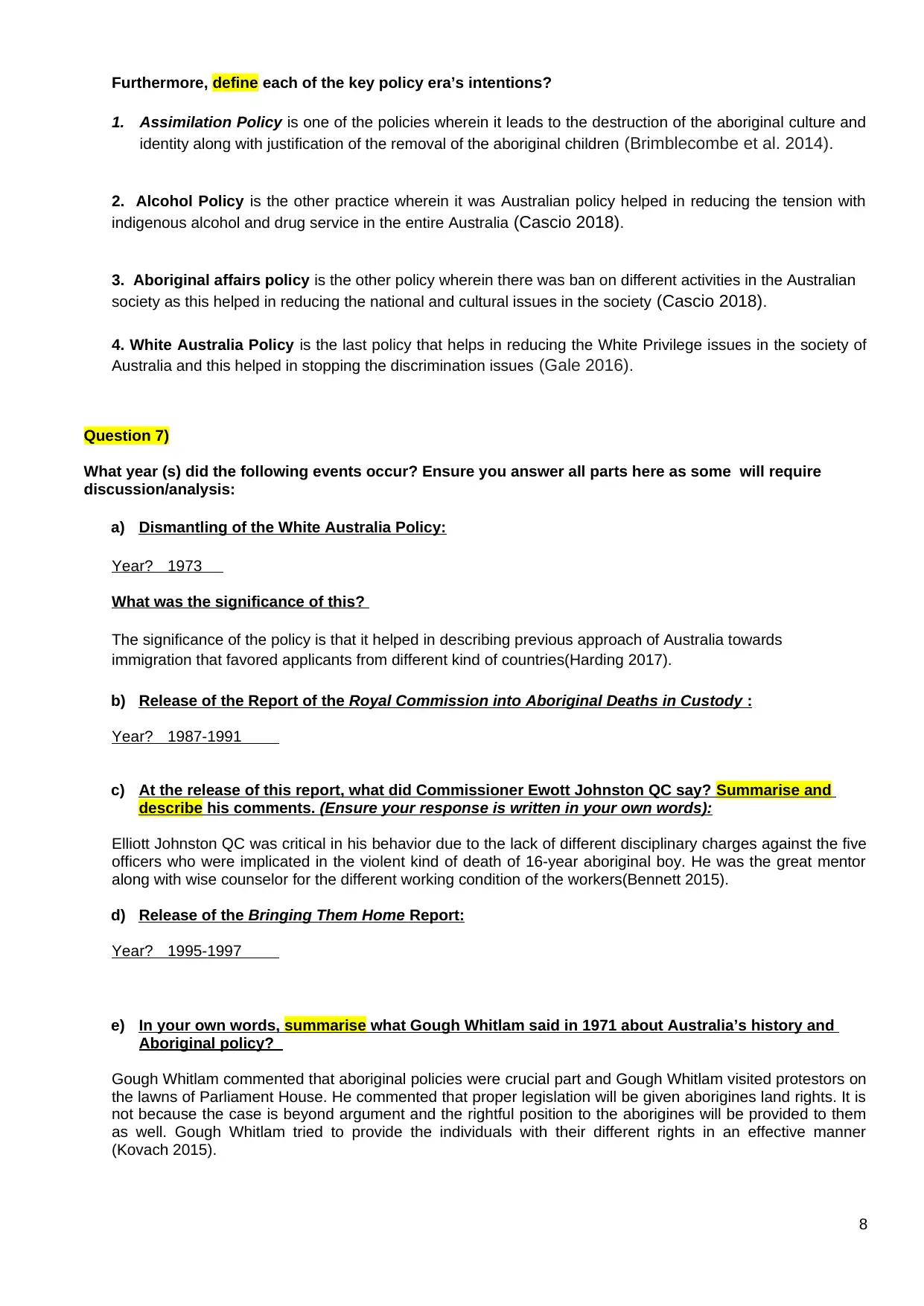
Furthermore, define each of the key policy era’s intentions?
1. Assimilation Policy is one of the policies wherein it leads to the destruction of the aboriginal culture and
identity along with justification of the removal of the aboriginal children (Brimblecombe et al. 2014).
2. Alcohol Policy is the other practice wherein it was Australian policy helped in reducing the tension with
indigenous alcohol and drug service in the entire Australia (Cascio 2018).
3. Aboriginal affairs policy is the other policy wherein there was ban on different activities in the Australian
society as this helped in reducing the national and cultural issues in the society (Cascio 2018).
4. White Australia Policy is the last policy that helps in reducing the White Privilege issues in the society of
Australia and this helped in stopping the discrimination issues (Gale 2016).
Question 7)
What year (s) did the following events occur? Ensure you answer all parts here as some will require
discussion/analysis:
a) Dismantling of the White Australia Policy:
Year? 1973
What was the significance of this?
The significance of the policy is that it helped in describing previous approach of Australia towards
immigration that favored applicants from different kind of countries(Harding 2017).
b) Release of the Report of the Royal Commission into Aboriginal Deaths in Custody :
Year? 1987-1991
c) At the release of this report, what did Commissioner Ewott Johnston QC say? Summarise and
describe his comments. (Ensure your response is written in your own words):
Elliott Johnston QC was critical in his behavior due to the lack of different disciplinary charges against the five
officers who were implicated in the violent kind of death of 16-year aboriginal boy. He was the great mentor
along with wise counselor for the different working condition of the workers(Bennett 2015).
d) Release of the Bringing Them Home Report:
Year? 1995-1997
e) In your own words, summarise what Gough Whitlam said in 1971 about Australia’s history and
Aboriginal policy?
Gough Whitlam commented that aboriginal policies were crucial part and Gough Whitlam visited protestors on
the lawns of Parliament House. He commented that proper legislation will be given aborigines land rights. It is
not because the case is beyond argument and the rightful position to the aborigines will be provided to them
as well. Gough Whitlam tried to provide the individuals with their different rights in an effective manner
(Kovach 2015).
8
1. Assimilation Policy is one of the policies wherein it leads to the destruction of the aboriginal culture and
identity along with justification of the removal of the aboriginal children (Brimblecombe et al. 2014).
2. Alcohol Policy is the other practice wherein it was Australian policy helped in reducing the tension with
indigenous alcohol and drug service in the entire Australia (Cascio 2018).
3. Aboriginal affairs policy is the other policy wherein there was ban on different activities in the Australian
society as this helped in reducing the national and cultural issues in the society (Cascio 2018).
4. White Australia Policy is the last policy that helps in reducing the White Privilege issues in the society of
Australia and this helped in stopping the discrimination issues (Gale 2016).
Question 7)
What year (s) did the following events occur? Ensure you answer all parts here as some will require
discussion/analysis:
a) Dismantling of the White Australia Policy:
Year? 1973
What was the significance of this?
The significance of the policy is that it helped in describing previous approach of Australia towards
immigration that favored applicants from different kind of countries(Harding 2017).
b) Release of the Report of the Royal Commission into Aboriginal Deaths in Custody :
Year? 1987-1991
c) At the release of this report, what did Commissioner Ewott Johnston QC say? Summarise and
describe his comments. (Ensure your response is written in your own words):
Elliott Johnston QC was critical in his behavior due to the lack of different disciplinary charges against the five
officers who were implicated in the violent kind of death of 16-year aboriginal boy. He was the great mentor
along with wise counselor for the different working condition of the workers(Bennett 2015).
d) Release of the Bringing Them Home Report:
Year? 1995-1997
e) In your own words, summarise what Gough Whitlam said in 1971 about Australia’s history and
Aboriginal policy?
Gough Whitlam commented that aboriginal policies were crucial part and Gough Whitlam visited protestors on
the lawns of Parliament House. He commented that proper legislation will be given aborigines land rights. It is
not because the case is beyond argument and the rightful position to the aborigines will be provided to them
as well. Gough Whitlam tried to provide the individuals with their different rights in an effective manner
(Kovach 2015).
8
⊘ This is a preview!⊘
Do you want full access?
Subscribe today to unlock all pages.

Trusted by 1+ million students worldwide
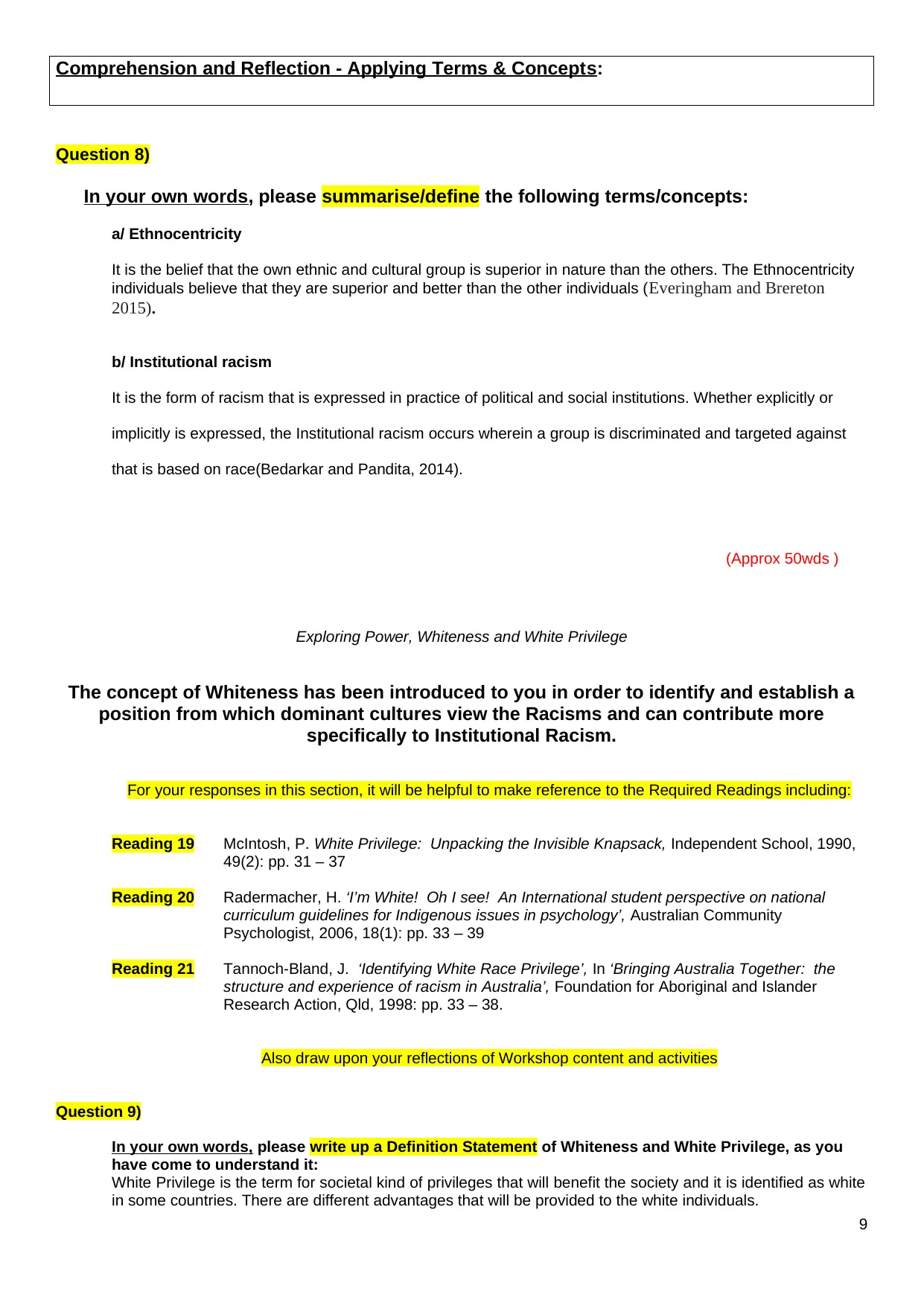
Comprehension and Reflection - Applying Terms & Concepts:
Question 8)
In your own words, please summarise/define the following terms/concepts:
a/ Ethnocentricity
It is the belief that the own ethnic and cultural group is superior in nature than the others. The Ethnocentricity
individuals believe that they are superior and better than the other individuals (Everingham and Brereton
2015).
b/ Institutional racism
It is the form of racism that is expressed in practice of political and social institutions. Whether explicitly or
implicitly is expressed, the Institutional racism occurs wherein a group is discriminated and targeted against
that is based on race(Bedarkar and Pandita, 2014).
(Approx 50wds )
Exploring Power, Whiteness and White Privilege
The concept of Whiteness has been introduced to you in order to identify and establish a
position from which dominant cultures view the Racisms and can contribute more
specifically to Institutional Racism.
For your responses in this section, it will be helpful to make reference to the Required Readings including:
Reading 19 McIntosh, P. White Privilege: Unpacking the Invisible Knapsack, Independent School, 1990,
49(2): pp. 31 – 37
Reading 20 Radermacher, H. ‘I’m White! Oh I see! An International student perspective on national
curriculum guidelines for Indigenous issues in psychology’, Australian Community
Psychologist, 2006, 18(1): pp. 33 – 39
Reading 21 Tannoch-Bland, J. ‘Identifying White Race Privilege’, In ‘Bringing Australia Together: the
structure and experience of racism in Australia’, Foundation for Aboriginal and Islander
Research Action, Qld, 1998: pp. 33 – 38.
Also draw upon your reflections of Workshop content and activities
Question 9)
In your own words, please write up a Definition Statement of Whiteness and White Privilege, as you
have come to understand it:
White Privilege is the term for societal kind of privileges that will benefit the society and it is identified as white
in some countries. There are different advantages that will be provided to the white individuals.
9
Question 8)
In your own words, please summarise/define the following terms/concepts:
a/ Ethnocentricity
It is the belief that the own ethnic and cultural group is superior in nature than the others. The Ethnocentricity
individuals believe that they are superior and better than the other individuals (Everingham and Brereton
2015).
b/ Institutional racism
It is the form of racism that is expressed in practice of political and social institutions. Whether explicitly or
implicitly is expressed, the Institutional racism occurs wherein a group is discriminated and targeted against
that is based on race(Bedarkar and Pandita, 2014).
(Approx 50wds )
Exploring Power, Whiteness and White Privilege
The concept of Whiteness has been introduced to you in order to identify and establish a
position from which dominant cultures view the Racisms and can contribute more
specifically to Institutional Racism.
For your responses in this section, it will be helpful to make reference to the Required Readings including:
Reading 19 McIntosh, P. White Privilege: Unpacking the Invisible Knapsack, Independent School, 1990,
49(2): pp. 31 – 37
Reading 20 Radermacher, H. ‘I’m White! Oh I see! An International student perspective on national
curriculum guidelines for Indigenous issues in psychology’, Australian Community
Psychologist, 2006, 18(1): pp. 33 – 39
Reading 21 Tannoch-Bland, J. ‘Identifying White Race Privilege’, In ‘Bringing Australia Together: the
structure and experience of racism in Australia’, Foundation for Aboriginal and Islander
Research Action, Qld, 1998: pp. 33 – 38.
Also draw upon your reflections of Workshop content and activities
Question 9)
In your own words, please write up a Definition Statement of Whiteness and White Privilege, as you
have come to understand it:
White Privilege is the term for societal kind of privileges that will benefit the society and it is identified as white
in some countries. There are different advantages that will be provided to the white individuals.
9
Paraphrase This Document
Need a fresh take? Get an instant paraphrase of this document with our AI Paraphraser
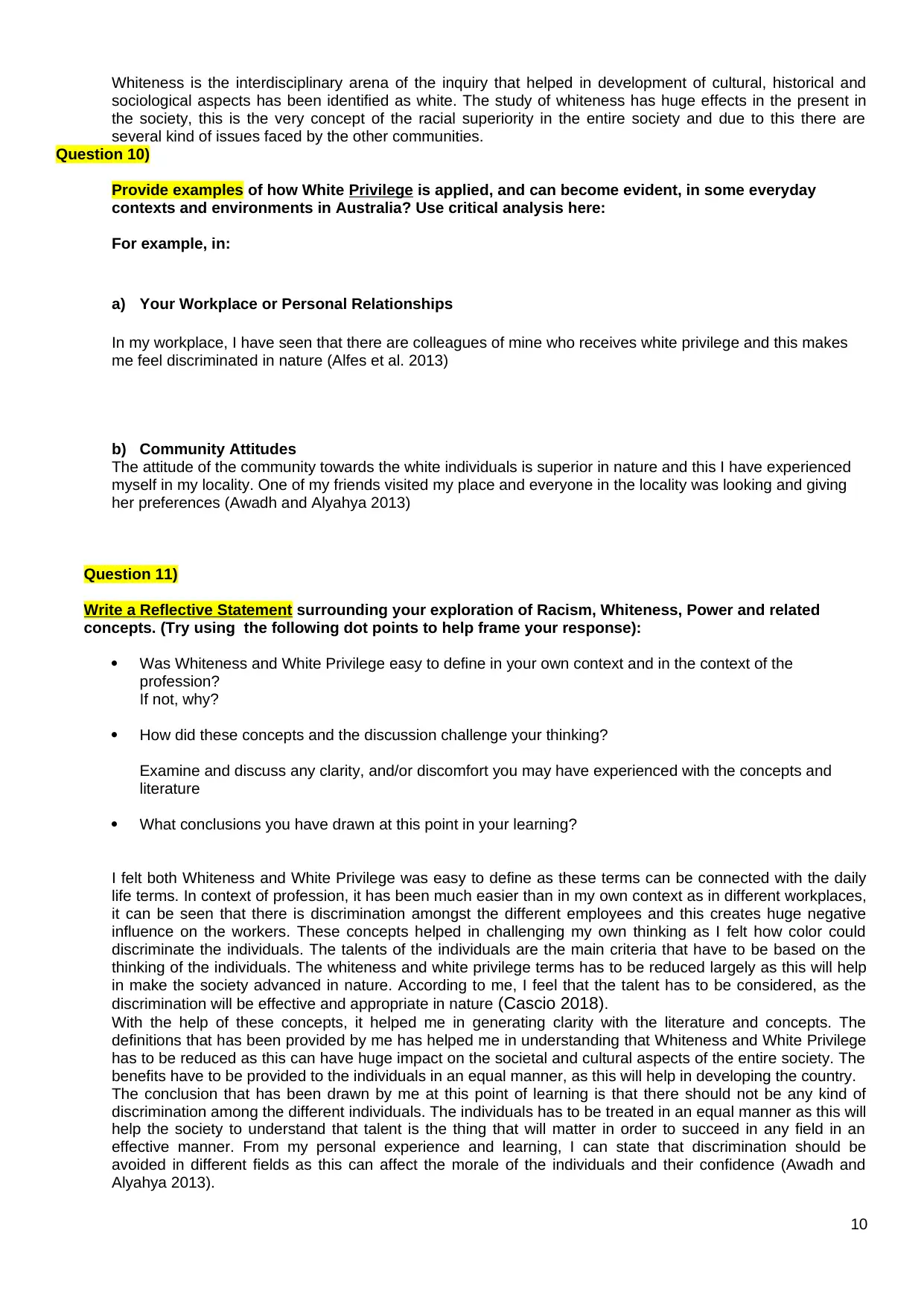
Whiteness is the interdisciplinary arena of the inquiry that helped in development of cultural, historical and
sociological aspects has been identified as white. The study of whiteness has huge effects in the present in
the society, this is the very concept of the racial superiority in the entire society and due to this there are
several kind of issues faced by the other communities.
Question 10)
Provide examples of how White Privilege is applied, and can become evident, in some everyday
contexts and environments in Australia? Use critical analysis here:
For example, in:
a) Your Workplace or Personal Relationships
In my workplace, I have seen that there are colleagues of mine who receives white privilege and this makes
me feel discriminated in nature (Alfes et al. 2013)
b) Community Attitudes
The attitude of the community towards the white individuals is superior in nature and this I have experienced
myself in my locality. One of my friends visited my place and everyone in the locality was looking and giving
her preferences (Awadh and Alyahya 2013)
Question 11)
Write a Reflective Statement surrounding your exploration of Racism, Whiteness, Power and related
concepts. (Try using the following dot points to help frame your response):
Was Whiteness and White Privilege easy to define in your own context and in the context of the
profession?
If not, why?
How did these concepts and the discussion challenge your thinking?
Examine and discuss any clarity, and/or discomfort you may have experienced with the concepts and
literature
What conclusions you have drawn at this point in your learning?
I felt both Whiteness and White Privilege was easy to define as these terms can be connected with the daily
life terms. In context of profession, it has been much easier than in my own context as in different workplaces,
it can be seen that there is discrimination amongst the different employees and this creates huge negative
influence on the workers. These concepts helped in challenging my own thinking as I felt how color could
discriminate the individuals. The talents of the individuals are the main criteria that have to be based on the
thinking of the individuals. The whiteness and white privilege terms has to be reduced largely as this will help
in make the society advanced in nature. According to me, I feel that the talent has to be considered, as the
discrimination will be effective and appropriate in nature (Cascio 2018).
With the help of these concepts, it helped me in generating clarity with the literature and concepts. The
definitions that has been provided by me has helped me in understanding that Whiteness and White Privilege
has to be reduced as this can have huge impact on the societal and cultural aspects of the entire society. The
benefits have to be provided to the individuals in an equal manner, as this will help in developing the country.
The conclusion that has been drawn by me at this point of learning is that there should not be any kind of
discrimination among the different individuals. The individuals has to be treated in an equal manner as this will
help the society to understand that talent is the thing that will matter in order to succeed in any field in an
effective manner. From my personal experience and learning, I can state that discrimination should be
avoided in different fields as this can affect the morale of the individuals and their confidence (Awadh and
Alyahya 2013).
10
sociological aspects has been identified as white. The study of whiteness has huge effects in the present in
the society, this is the very concept of the racial superiority in the entire society and due to this there are
several kind of issues faced by the other communities.
Question 10)
Provide examples of how White Privilege is applied, and can become evident, in some everyday
contexts and environments in Australia? Use critical analysis here:
For example, in:
a) Your Workplace or Personal Relationships
In my workplace, I have seen that there are colleagues of mine who receives white privilege and this makes
me feel discriminated in nature (Alfes et al. 2013)
b) Community Attitudes
The attitude of the community towards the white individuals is superior in nature and this I have experienced
myself in my locality. One of my friends visited my place and everyone in the locality was looking and giving
her preferences (Awadh and Alyahya 2013)
Question 11)
Write a Reflective Statement surrounding your exploration of Racism, Whiteness, Power and related
concepts. (Try using the following dot points to help frame your response):
Was Whiteness and White Privilege easy to define in your own context and in the context of the
profession?
If not, why?
How did these concepts and the discussion challenge your thinking?
Examine and discuss any clarity, and/or discomfort you may have experienced with the concepts and
literature
What conclusions you have drawn at this point in your learning?
I felt both Whiteness and White Privilege was easy to define as these terms can be connected with the daily
life terms. In context of profession, it has been much easier than in my own context as in different workplaces,
it can be seen that there is discrimination amongst the different employees and this creates huge negative
influence on the workers. These concepts helped in challenging my own thinking as I felt how color could
discriminate the individuals. The talents of the individuals are the main criteria that have to be based on the
thinking of the individuals. The whiteness and white privilege terms has to be reduced largely as this will help
in make the society advanced in nature. According to me, I feel that the talent has to be considered, as the
discrimination will be effective and appropriate in nature (Cascio 2018).
With the help of these concepts, it helped me in generating clarity with the literature and concepts. The
definitions that has been provided by me has helped me in understanding that Whiteness and White Privilege
has to be reduced as this can have huge impact on the societal and cultural aspects of the entire society. The
benefits have to be provided to the individuals in an equal manner, as this will help in developing the country.
The conclusion that has been drawn by me at this point of learning is that there should not be any kind of
discrimination among the different individuals. The individuals has to be treated in an equal manner as this will
help the society to understand that talent is the thing that will matter in order to succeed in any field in an
effective manner. From my personal experience and learning, I can state that discrimination should be
avoided in different fields as this can affect the morale of the individuals and their confidence (Awadh and
Alyahya 2013).
10

11
⊘ This is a preview!⊘
Do you want full access?
Subscribe today to unlock all pages.

Trusted by 1+ million students worldwide
1 out of 15
Related Documents
Your All-in-One AI-Powered Toolkit for Academic Success.
+13062052269
info@desklib.com
Available 24*7 on WhatsApp / Email
![[object Object]](/_next/static/media/star-bottom.7253800d.svg)
Unlock your academic potential
Copyright © 2020–2025 A2Z Services. All Rights Reserved. Developed and managed by ZUCOL.





